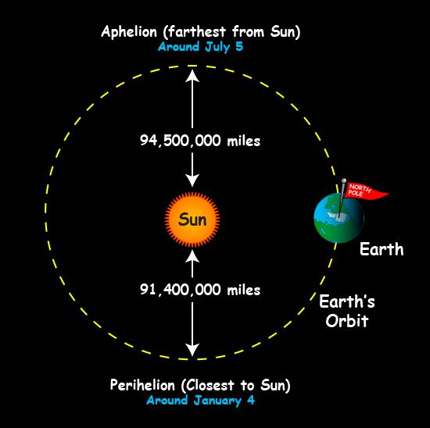JANUARY AND JUNE / WINTER AND SUMMER
When Earth is closest to the sun, it is winter in the northern hemisphere and summer in the southern hemisphere. Thus it is possible to see that Earth's distance from the sun does not noticeably cause the seasons to change; the relatively minor effects of differences in distance is somewhat masked by the mainly oceanic southern hemisphere vs the half- continental northern hemisphere. Therefore, the Earth's seasons come and go mainly because Earth does not rotate with its axis exactly upright with respect to the plane of our world’s orbit around the sun. Earth's axial tilt is 23.5 degrees. This puts the Sun farther south in December and January, so the north has winter and the south has summer. Thus winter falls on that part of the globe where sunlight strikes least directly. Summer falls on that part of the globe where sunlight strikes most directly.There’s not a huge distance difference between perihelion and aphelion. Earth’s orbit is very nearly circular. Thus it’s not our distance from the sun – but instead the tilt of our world’s axis – that creates winter and summer on Earth.
 |
| Diagram showing tilt of Earth |
Earth’s closest and farthest points to the sun do affect seasonal lengths. When the Earth comes closest to the sun for the year, as around now, our world is moving fastest in orbit around the sun. Earth is rushing along now at almost 19 miles per second (30.3 km/sec) – moving about .6 miles per second (one kilometer per second) faster than when Earth is farthest from the sun in early July. Thus the Northern Hemisphere winter and – simultaneously – the Southern Hemisphere summer are the shortest seasons as Earth rushes from the solstice in December to the equinox in March.

In the Northern Hemisphere, the summer season (June solstice to September equinox) lasts nearly five days longer than our winter season. And, of course, the corresponding seasons in the Southern Hemisphere are opposite. Southern Hemisphere winter is nearly five days longer than Southern Hemisphere summer.

It’s all due to the shape of Earth’s orbit. The shape is an ellipse, like a circle someone sat down on and squashed. The elliptical shape of Earth’s orbit causes the variation in the length of the seasons – and brings us closest to the sun in January.
Why is it hot in summer and cold in winter
Because the earth's axis is tilted.
It is all about the tilt of the Earth's axis. Many people believe that the temperature changes because the Earth is closer to the sun in summer and farther from the sun in winter. In fact, the Earth is farthest from the sun in July and is closest to the sun in January!
During the summer, the sun's rays hit the Earth at a steep angle. The light does not spread out as much, thus increasing the amount of energy hitting any given spot. Also, the long daylight hours allow the Earth plenty of time to reach warm temperatures.
During the winter, the sun's rays hit the Earth at a shallow angle. These rays are more spread out, which minimizes the amount of energy that hits any given spot. Also, the long nights and short days prevent the Earth from warming up. Thus, we have winter!
No comments:
Post a Comment